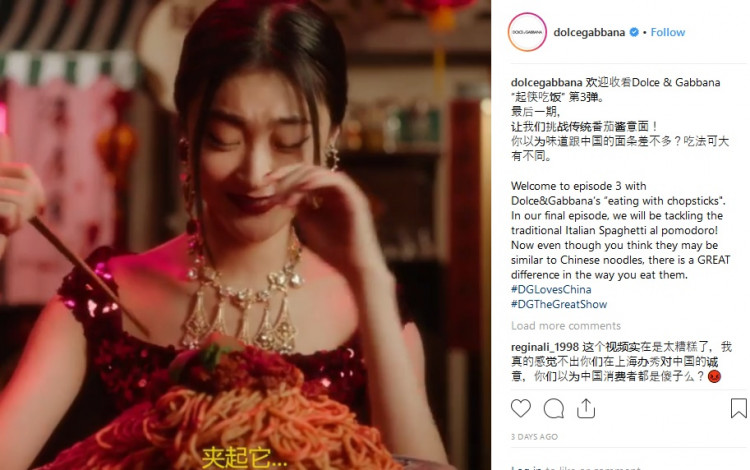The Chinese, of whom 7.6 million households purchased luxury goods in 2016 alone, were angered by Dolce & Gabbana's "DG Loves China" campaign which, according to the fashion high-end brand was supposedly intended to give tribute to the Asian traditions.
Instead of serving as an accolade to the Chinese culture, the campaign came as racist and completely disrespectful. To some extent, netizens called it "cheap shot."
In a three-part video, the advert featured a young Asian lady wearing a red Chinese inspired dress. The videos showed her having a hard time using her chopsticks while eating a pizza, then pasta, and finally cannoli. Each time, a male-voice narrator teaches her how to use the chopstick to eat each of the Italian food.
The Chinese were particularly angered by how the campaign depicted the model as the stereotype used in much Western content. The props, like the lanterns and couplets, used in the video were also intentionally made to look like cliché seen in old films. To make matters worse, the quality of the video seemed to have been intended to look like a low-budgeted production.
The most distasteful part of the video was when the male narrator asked the model if the Italian cannoli was "too big for her." The subtitles of the advert also referred to the chopsticks as "small-stick" tool.
Jing Daily reported that the furor over the campaign was intense that Dolce & Gabbana had to take the post down from a local social media platform. There has since been a national call on Weibo to "Boycott Dolce." Some demanded Dolce & Gabbana issue a public apology.
Dolce & Gabbana, however, seemed unbothered about the whole controversy. A check conducted by Business Times staff revealed that the advert remains uploaded on Dolce & Gabbana's international social media accounts such as Instagram and Facebook. Netizens have also been suspecting that the fashion brand intentionally made the campaign as shameful as it is in order to garner views or for it to go viral.
The fashion brand seemed unmindful of losing its share of the Chinese market which on 2016 comprised as much as 30 percent of their worldwide sales.
If the "Boycott Dolce" became a success and was able to push the fashion brand out of the Chinese market, Dolce & Gabbana will find itself losing the Chinese millionaires who according to a 2017 McKinsey&Company report is expected to surpass any other nation.
The report said China, by 2021, will be the home to the most affluent households in the world. In 2016, 7.6 million Chinese households bought luxury goods. This number was larger than the number of all households in Malaysia and the Netherlands, the report said.
Each of these 7.6 million households bought about $10,000 luxury goods per year, twice the value of what French and Italian households spent.
At present, Chinese luxury consumers accounted for more than $72 billion in annual spending or a third of the global luxury market. By 2025, they are expected to account for as much as 44 percent of the global luxury market. Also, by this year, the 7.6 million Chinese households will contribute an estimated total of $143 billion in global luxury sales.






